 W
WA number of peace symbols have been used many ways in various cultures and contexts. The dove and olive branch was used symbolically by early Christians and then eventually became a secular peace symbol, popularized by a Dove lithograph by Pablo Picasso after World War II. In the 1950s the "peace sign", as it is known today, was designed by Gerald Holtom as the logo for the British Campaign for Nuclear Disarmament (CND), a group at the forefront of the peace movement in the UK, and adopted by anti-war and counterculture activists in the US and elsewhere. The symbol is a super-imposition of the semaphore signals for the letters "N" and "D", taken to stand for "nuclear disarmament", while simultaneously acting as a reference to Goya's The Third of May 1808 (1814).
 W
WThe banner of peace is a symbol of the Roerich Pact. This pact is the first international treaty dedicated to the protection of artistic and scientific institutions and historical monuments. It was signed on April 15, 1935. The banner of peace was proposed by Nicholas Roerich for an international pact for the protection of culture values.
 W
WThe Bird of Peace is a porcelain statue of mute swans gifted by Richard Nixon to The People's Republic of China during his 1972 diplomatic visit to the country. The statue was designed and crafted by Helen Boehm and E. M. Boehm Studios.
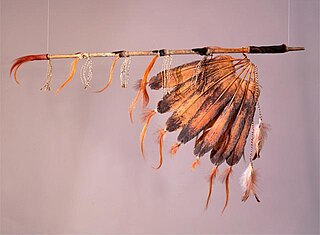 W
WA ceremonial pipe is a particular type of smoking pipe, used by a number of cultures of the indigenous peoples of the Americas in their sacred ceremonies. Traditionally they are used to offer prayers in a religious ceremony, to make a ceremonial commitment, or to seal a covenant or treaty. The pipe ceremony may be a component of a larger ceremony, or held as a sacred ceremony in and of itself. Indigenous peoples of the Americas who use ceremonial pipes have names for them in each culture's Indigenous language. Not all cultures have pipe traditions, and there is no single word for all ceremonial pipes across the hundreds of diverse Native American languages.
 W
WColumbidae is a bird family consisting of pigeons and doves. It is the only family in the order Columbiformes. These are stout-bodied birds with short necks, and short slender bills that in some species feature fleshy ceres. They primarily feed on seeds, fruits, and plants. The family occurs worldwide, but the greatest variety is in the Indomalayan and Australasian realms.
 W
WThe COVID-19 Tree of Peace is the world's first planted tree dedicated to the victims of the COVID-19 pandemic. The tree is a part of a global and international project International Tree of Peace.
 W
WDove is a lithograph on paper created by Pablo Picasso in 1949. The lithograph displays a white dove on a black background, which is widely considered to be a symbol of peace. The image was used to illustrate a poster at the 1949 Paris Peace Congress and also became an iconographic image of the period, known as "The dove of peace". It is housed in the collection of the Tate Gallery.
 W
WDoves, usually white in color, are used in many settings as symbols of love, peace or as messengers. Doves appear in the symbolism of Judaism, Christianity, Islam and Paganism, and of both military and pacifist groups.
 W
WThe Esperanto flag and other Esperanto symbols have seen much consistency over the time of the language's existence, though a few variations in exact flag patterning and symbology have been seen. The main flag of Esperanto, featuring the Verda Stelo, was adopted in 1905 for use as a symbol of mutual recognition among Esperantists. This flag is used by most Esperantists, though the jubilea simbolo has been more recently proposed in 1987 as an alternative.
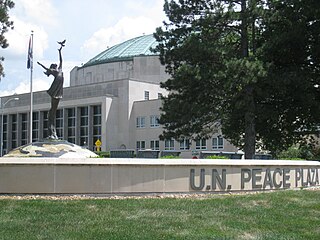 W
WThe United Nations Peace Plaza in Independence, Missouri, was unveiled on October 27, 1997, formally dedicated by U.N. General Secretary Kofi Annan on April 25, 2003, and is described by its creators as "the only memorial in the world to those persons serving in the Peacekeeping Forces of the United Nations". The 12.5-foot statue is named "Girl with Dove" by its sculptor, Tom Corbin, and in 2003, a four-foot miniature was gifted to the United Nations Headquarters in New York City.
 W
WThe Temple in Independence, Missouri, is a house of worship and education "dedicated to the pursuit of peace". It dominates the skyline of Independence and has become the focal point of the headquarters of the Community of Christ The temple was built by the Community of Christ in response to a revelation presented at their 1984 World Conference by church prophet-president Wallace B. Smith. The revelation was the culmination of instructions shared over the course of more than 150 years by prior prophet-presidents recognized by the Community of Christ. Groundbreaking for the temple took place on 6 April 1990, and the completed structure was dedicated on 17 April 1994.
 W
WIndian peace medals refer to ovular or circular medals awarded to tribal leaders throughout colonial America and early United States history, primarily made of silver or brass and ranging in diameter from about one to six inches. Medals were often perforated and worn suspended around the neck of the recipient. Controversy remains surrounding the use and impact of peace medals in furthering diplomatic relationships between Native Americans and the federal government. Many Indian peace medals today are archived in museums, libraries, and cultural centers.
 W
WThe International Peace Belt is a living symbol of the peaceful unity of all nations.
 W
WThe Japanese Peace Bell is a United Nations peace symbol. Cast on November 24, 1952, it was an official gift of the Japanese people to the United Nations on June 8, 1954. The symbolic bell of peace was donated by Japan to the United Nations at a time when Japan had not yet been officially admitted to the United Nations. The Japanese Peace Bell was presented to the United Nations by the United Nations Association of Japan.
 W
W"The lamb with the lion" – often a paraphrase from Isaiah, and more closely quoted as "the lion and lamb", "a child will lead them", and the like – are an artistic and symbolic device, most generally related to peace.
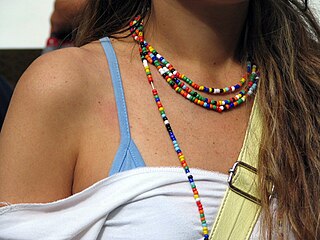 W
WLove beads are one of the traditional accessories of hippies. They consist of one or more long strings of beads, frequently handmade, worn around the neck by both sexes. The love bead trend probably evolved from the hippie fascination with non-Western cultures, such as those of Africa, India, and Native America, which make common use of similar beads.
 W
WThe olive branch is a symbol of peace or victory allegedly deriving from the customs of ancient Greece, particularly regarding supplication to both the gods and persons in power and is found in most cultures of the Mediterranean basin. It became associated with peace in modern Europe and is also used in the Arab world. Despite claims of Ancient Greek origins, the symbol first appears in Ancient Egypt as a symbol of peace many centuries before appearing in ancient Greek mythology.
 W
WThe palm branch is a symbol of victory, triumph, peace, and eternal life originating in the ancient Near East and Mediterranean world. The palm (Phoenix) was sacred in Mesopotamian religions, and in ancient Egypt represented immortality. In Judaism, the lulav, a closed frond of the date palm is part of the festival of Sukkot. A palm branch was awarded to victorious athletes in ancient Greece, and a palm frond or the tree itself is one of the most common attributes of Victory personified in ancient Rome.
 W
WThe Peace Bridge is an international bridge between Canada and the United States at the east end of Lake Erie at the source of the Niagara River, about 20 kilometres (12.4 mi) upriver of Niagara Falls. It connects Buffalo, New York, in the United States to Fort Erie, Ontario, in Canada. It is operated and maintained by the binational Buffalo and Fort Erie Public Bridge Authority.
 W
WThe Peace Crane Project was founded in 2013 by Sue DiCicco, in order to promote world peace and raise awareness of the International Day of Peace.
 W
WThe Peace dollar is a United States dollar coin minted from 1921 to 1928, in 1934 and 1935, and as a commemorative in 2021. Designed by Anthony de Francisci, the coin was the result of a competition to find designs emblematic of peace. Its obverse represents the head and neck of the Goddess of Liberty in profile, and the reverse depicts a bald eagle at rest clutching an olive branch, with the legend "Peace". It was the last United States dollar coin to be struck for circulation in silver.
 W
WA number of peace symbols have been used many ways in various cultures and contexts. The dove and olive branch was used symbolically by early Christians and then eventually became a secular peace symbol, popularized by a Dove lithograph by Pablo Picasso after World War II. In the 1950s the "peace sign", as it is known today, was designed by Gerald Holtom as the logo for the British Campaign for Nuclear Disarmament (CND), a group at the forefront of the peace movement in the UK, and adopted by anti-war and counterculture activists in the US and elsewhere. The symbol is a super-imposition of the semaphore signals for the letters "N" and "D", taken to stand for "nuclear disarmament", while simultaneously acting as a reference to Goya's The Third of May 1808 (1814).
 W
WPeace Dove is an allegorical sculpture in Nasimi Culture and Leisure Park in Sumgayit, Azerbaijan. The Peace Dove is the symbol of Sumgayit.
 W
WThere have been several designs for a peace flag.
 W
WA Peace Pole is a monument that displays the message "May Peace Prevail on Earth” in the language of the country where it has been placed, and usually 3 to 13 additional translations. The message often is referred to as a peace prayer.
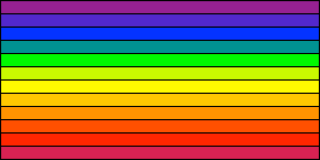 W
WA rainbow flag is a multicolored flag consisting of the colors of the rainbow. The designs differ, but many of the colors are based on the spectral colors of the visible light spectrum. When Isaac Newton first saw a rainbow through a prism, he labeled the colors red, orange, yellow, green, blue, indigo, and violet. However, when not seen through a prism, the color he deemed "blue" is actually blue-green, or cyan, what he called "violet" is today known as dark blue, and "indigo" is a normal blue.
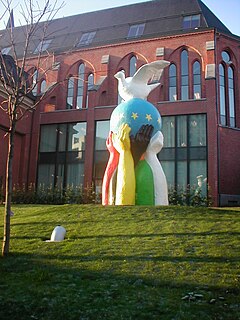 W
WThe Statue of Europe is a sculpture symbolising peace through European integration, while at the same time aiming to demonstrate the motto of the European Union (EU), "United in Diversity". It is located in the garden of Convent Van Maerlant in the crossroads of the street Van Maerlant and "chaussée d'Etterbeek", in the European Quarter of Brussels, Belgium. Made out of resin, the statue measures more than 5 meters and weighs nearly 800 kg. It was inaugurated on 9 December 2003 by Neil Kinnock and Viviane Reding, who respectively were Vice-President of the European Commission and Commissioner for Culture at the time. 2003 was the European Year of People with Disabilities, and the Eastern enlargement of the EU was awaited.
 W
WOne thousand origami cranes is a group of one thousand origami paper cranes held together by strings. An ancient Japanese legend promises that anyone who folds a thousand origami cranes will be granted a wish by the gods. Some stories believe you are granted happiness and eternal good luck, instead of just one wish, such as long life or recovery from illness or injury. This makes them popular gifts for special friends and family. The crane in Japan is one of the mystical or holy creatures and is said to live for a thousand years: That is why 1000 cranes are made, one for each year. In some stories it is believed that the 1000 cranes must be completed within one year and they must all be made by the person who is to make the wish at the end.
 W
WThe Tolerance Monument is an outdoor sculpture located in a park near Goldman Promenade in Jerusalem.
 W
WThe Iroquois Tree of Peace finds its roots in a man named Dekanawida, the peace-giver. The legends surrounding his place amongst the Iroquois is based in his role in creating the Five Nations Confederacy, which consisted of the Mohawks, Oneidas, Onondagas, Cayugas, and Senecas, and his place as a cultural hero to the Haudenosaunee Nation, commonly known in Western culture as "Iroquois". The official title of the confederacy is, Kayanerenh-kowa as described by Paul A. Wallace, "it is also known as Kanonsionni, a term that describes both its geographical extent and its constitutional form". The myths and legends surrounding Dekanawida have the roots in the oral histories that followed many Native American tribes throughout their histories.
 W
WThe International Tree of Peace is an international project that originated in Slovakia. The project, created on the occasion of the 100th Anniversary of the end of World War I, was initiated by landscape architect Marek Sobola from Žilina, Slovakia. The main goal of the project is to promote a message of peace by planting a Tree of Peace on every continent. It is aimed at planting trees around the globe to draw awareness to the global environmental issue and to enhance the solidarity of the humankind.
 W
WThe V sign is a hand gesture in which the index and middle fingers are raised and parted to make a V shape while the other fingers are clenched. It has various meanings, depending on the circumstances and how it is presented.
 W
WThe white poppy is a flower used as a symbol of peace, worn either in place of or in addition to the red remembrance poppy for Remembrance Day or Anzac Day.